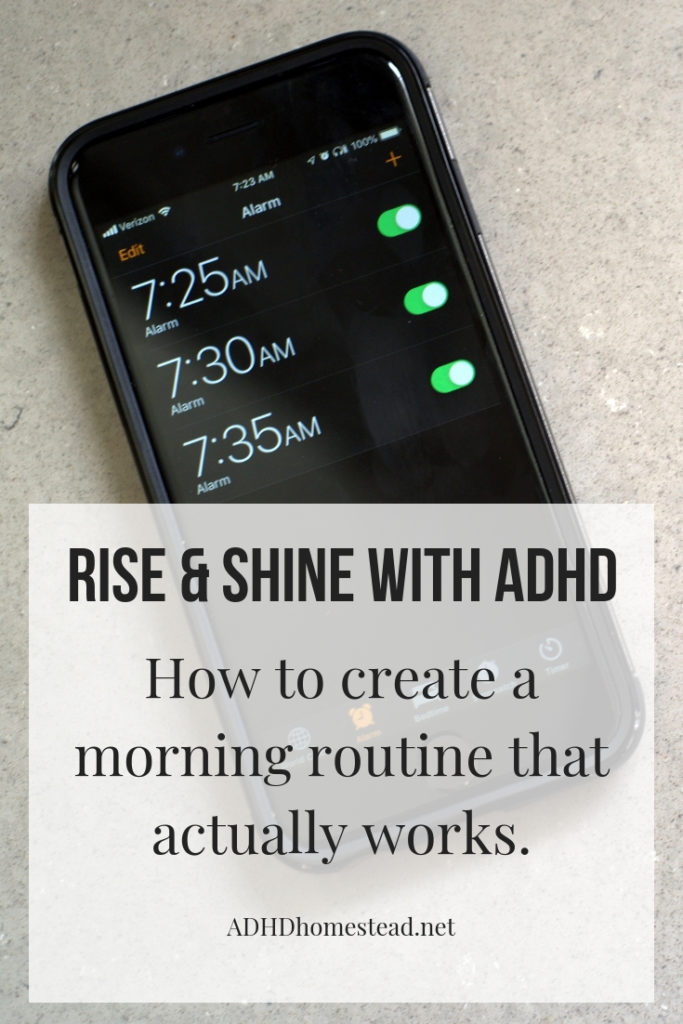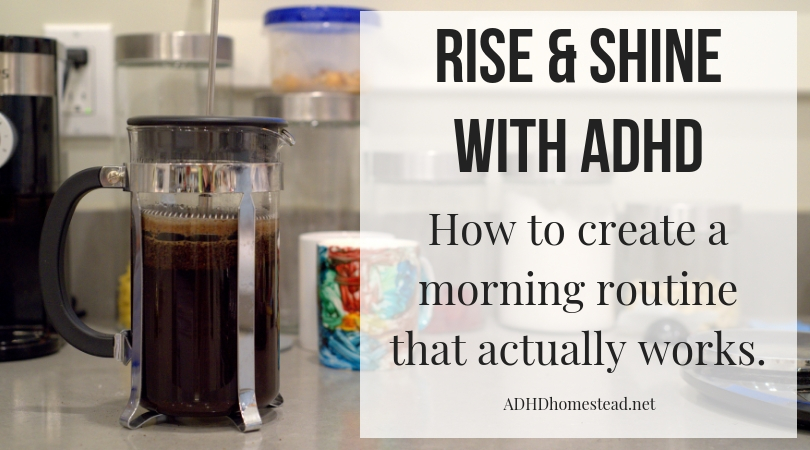We all need a morning routine. How else can we remember everything and still get out the door on time? Creating this routine isn’t easy for people with ADHD. For some of us, the only routine element is chaos.
No one taught me how to wake up and get out of the house in the morning. At least not beyond, “Set your alarm early enough to get everything done by the time you have to leave.” Well, obviously. One of the most frustrating aspects of living with adult ADHD is knowing what I need to do — and having it seem so painfully basic — and yet not being able to figure out how to get it done.

People with ADHD struggle with multi-step processes, and that’s exactly what a morning routine is. We need to consider what needs to be done, in what order, and how long each task will take. Even though the tasks should be easy — shower, get dressed, pack lunch — our brains don’t do a good job of pulling all the pieces together.
My secret: Work backward, and work it out on paper. I do this whenever our family needs to get out the door by a specific time, but especially when we have flights or other hard deadlines. If your morning routine is a mess, don’t just think through the process. Actually sit down and work it all out on paper. I take these steps whenever I need a new or different morning routine:
Identify when you need to walk out the door.
Write the time you need to arrive at your destination. For example, if I have a flight that departs at 8:10, I aim to arrive at the airport at around 7:10. That means I should get to the long-term parking lot by 6:55. When I worked retail, I tried to pull into the parking lot 5-10 minutes before my shift started. I needed time to walk to the back of the store, clock in, and put on any last pieces of my uniform. Arriving on time usually means arriving a little early.
Once you know when you want to arrive, estimate your travel time as generously as possible. If Google Maps says it should take 35-55 minutes to get to your destination, go with 55. If you can get to work in 20 minutes but traffic sometimes makes it 35, give yourself 35 minutes. Even if you’re walking to your destination, pay attention to the variables: if it’s hot, will you walk slower so you don’t arrive drenched in sweat? When you subtract your maximum reasonable travel time from your arrival time, you have the time you need to leave.
However, this is the time you need to pull (or walk) away from the curb, not necessarily the time you need to walk out the front door. Many of us have several jobs to do between walking out the door and actually leaving, but we forget to leave time to do them. For example: buckling multiple children into car seats, letting the engine warm up or scraping ice from the windshield, securing a surfboard to your roof rack, or making multiple trips to load cargo into your trunk. Add this to your travel time to find the real time you need to walk out the door with your coat on and bags packed.
Make a morning to-do list
If you think this sounds childish, think again. People with ADHD often have weak working memory. This means we have a lot of trouble holding more than one thing in our minds at once. When we imagine something like a morning routine, which includes a lot of little steps, it feels like a big jumble. Overwhelmed, we invent a reasonable time in which we should be able to get everything done — say, 90 minutes — without any evidence that this expectation is reasonable. And we often discover it’s not.
When you’re first adapting to a new daily routine, or when something like a vacation or a big presentation at work alters that routine, write down everything you’ll need to do. On any given weekday morning, your family may need to:
- Pack lunches for work and school
- Shower and shave
- Brush teeth
- Prepare breakfast
- Clear the table and load the dishwasher
- Put on socks and shoes (can take more time than you think for young children)
- …etc.
Making this list also gives you an idea of what you can skip on an extra-early morning. If we have to be at the airport at 7:00, I pack my bags and shower the night before. I wake up with barely enough time to throw some clothes on, brush my teeth, and make my bed. We live close enough to the airport that I can grab a coffee and a breakfast sandwich when I get there…assuming nothing goes wrong. Hopefully this never goes poorly for an innocent TSA agent stuck between me and my morning sustenance.
Time your morning.
Once you have your morning routine outlined, ask yourself for each item: how long does this usually take? Not how long should it take, but how long in real life. If you don’t know, time it with a stopwatch tomorrow morning. Always use real times, not wishful thinking times.
Be honest and non-judgemental about what you need to do in the morning and how long it takes you. Add everything up on paper. You’ll probably miss something, and that’s okay. Add it as soon as you think of it. When you’re finished, you will have a clear picture of what your morning routine is and how long it takes.
So when do you need to wake up?
I recommend taking the length of your morning routine, adding 30 minutes, and using that to find your wake-up time. You may do just fine with a 15-minute buffer, especially if you live alone and don’t have any children or pets. Children and pets have a way of making unexpected messes right when you haven’t a single minute to spare. Try to stay one step ahead of this and any other surprises: phone calls, a coffee spill, or realizing you forgot to wash your lunch container the night before. These seem like minor events, but they can make some people with ADHD feel very flustered and angry. You don’t want that for your morning.
Once you have your wakeup time, set your alarm in a way that will have you out of bed by that time. I’m the child of two working parents. By the time I started middle school, they often left for work before I got up in the morning. I never missed the school bus because I knew I couldn’t afford to, and I still wake up well to alarms. My husband, on the other hand, is a recovering snoozer. I’ve always marveled at his ability to hit snooze on repeat, or even accidentally go back to sleep after turning the alarm off. If you know you’re going to hit snooze, set your alarm for earlier than your true wakeup time.
Morning routines are anything but simple.
Because of ADHD’s time perception and working memory deficits, people with ADHD need to be a lot more intentional about how we plan our mornings. Most of us don’t have an accurate sense of what we need to do and how long it will take. That’s why we need to sit down with a piece of paper to figure out how to make our mornings work.
Of course, once you set your morning routine, you need to stay vigilant for obstacles. Sometimes we put up roadblocks for ourselves. Sometimes our family derails us. Either way, we need to protect our health and sanity while dealing with the practicalities of getting out the door every morning. Stay tuned next week for part two of this post: six habits to stop sabotaging your morning routine.
Do you have any morning routine tricks and tips? Please share them in the comments!
Hey there! Are you enjoying The ADHD Homestead?
Here's the thing: I don't like ads. I don't want to sell your attention to an advertising service run by the world's biggest data mining company. I also value my integrity and my readers' trust above all, which means I accept very few sponsorships/partnerships.
So I'm asking for your support directly. For the cost of one cup of coffee, you can help keep this site unbiased and ad-free.
Below you will find two buttons. The first lets you join our crew of Patreon pals and pledge monthly support for my work. Patrons also have access to my Audioblogs podcast. The second takes you to a simple donation page to pledge one-time or recurring support for The ADHD Homestead, no frills, no strings. Do whichever feels best for you!

